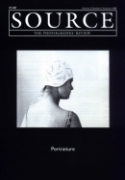Grapevine
Book Review by Leon McAuley
Issue 9 Autumn 1996
View Contents ▸
Published by: Cornerhouse Publications
ISBN: 0948797134
Price: £40.00
What prompted Susan Lipper to document the lives of the denizens of grapevine Hollow, West Virginia, between 1988 and 1993? Well, according to her introduction, she didn't. The book is, she says, not so much an "effort to document", as "the collusion of my experiences..." - a revealing construction in itself - "...the tangible world and the nature of photography". Really?
Grapevine is a handsome volume. Forty-two photographs, thirteen pages of interviews - described as 'conversations' - with the Grapevine natives: gun totin', hard drinkin' gamblers, moonshiners, bloody mamas an' good ole boys. The backdrop, beat-up chevvies, birches, Elvis shrines and ole time religion is equally unsurprising. American Gothic.
The text is excellent, and wisely placed after the photographs. The transaction catches the rhythm, the editing is deft: the balance between the stoical acceptance and irresponsible bravado is spot on. The questions are loaded, intended to shock:
SL: (to Bob) Do you think a woman has a right to an opinion?
SL: Is she the only woman that ever shot at you Gene? This seems a one-sided kind of 'collusion'.
When Richard Avedon photographs American Gothic he's taking something his subjects may or may not know they're giving. For this reason his pictures have been questioned. Exploitation or quest for truth? Either way, Avedon's photographs are proofs of an uneasy relationship. They are, as he would punningly say himself, 'evidence', they're 'Avedon's'. He's not going for the easy or expected. There's no irresponsible bravado in the faces. Nobody's smiling, either side of his camera. Cusps in a psychic battle, they are confrontations and the fighting has not stopped. Susan Lipper is not confronting anybody. Her subjects are playing to the camera and she's letting them. Their irresponsible bravado might even be the subject, though I don't believe it is. The rusty trailers, Elvis shrines and chevvies - 'the tangible world' - are evidence that she was there, but they are circumstantial evidence: not evidence of 'an intimacy never before imagined', nor of understanding. They are the kind of evidence that Avedon eschews.
As for colliding with the nature of photography, well on-camera flash and printing the film edges are hardly revolutionary devices these days, and anybody who believes in them might well believe an interview is a conversation. There is manipulation going on. It's a sign of nerve rather than honesty to print a two-and-a-quarter-square negative whole. The square is a notoriously difficult format. For all its authority, stability and chic, only masters can deal with it raw. An image earns the viewer's attention by the photographer using every means at her disposal to extract and distil the interest she finds in the subject. For mere mortals, like myself and Ms. Lipper, that means, dishonest though they may be thought, cropping, dodging, composition. Yes, that's manipulation, but so is choosing a subject, a viewpoint, a particular fraction of a second, then selecting from a greater number of images to represent the truth.
Nor will I easily accept a photographer demanding my attention to an image just because it's part of any 'collusion of experiences'. Photographs have a relationship with the real that other forms of representation would give their eye teeth for, but it's self indulgent to say, 'Its real, I found it interesting, therefore you must find it interesting too...' The image, while it may be inherently interesting - has to be arresting, revealing, stimulating, coherent, by the photographer's technical and editorial skill - by manipulation. And, as I suggested earlier, every part of the process of taking a photograph is an act of choice, selection and manipulation - from that first thought, 'Will I get up today?' to the finished print or book.
By their very nature photographs are fictitious representations of reality. Time does not jerk along incrementally a hundred or a thousand times a second, and while reality may well exist in the flux of spatial and tonal relationship taking place before our very eyes, truth does not. Nor does truth reside in the stasis of a photograph. Let's be realistic. A photograph is the chemical manifestation of an intellectually guided shot-in-the-dark, intentionally or accidentally illustrating a particular thesis. If it happens to seem to represent a truth it's either because the photographer was inordinately lucky, or because the photographer is prepared to countenance the white lie. We are all in on it. Why pretend otherwise? There is no more need to be puritanical than to be picturesque. The image, however it is achieved, is everything, and there are several extraordinary images in this book.
Other articles mentioning Richard Avedon:
Other articles on photography from the 'Documentary' category ▸





